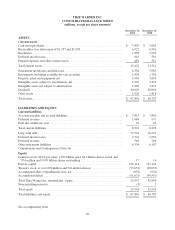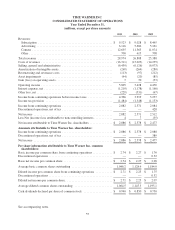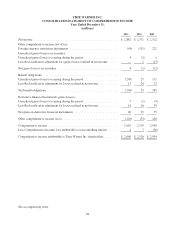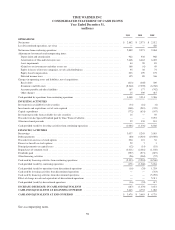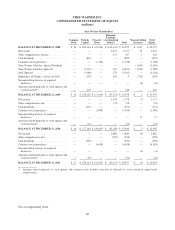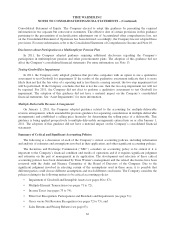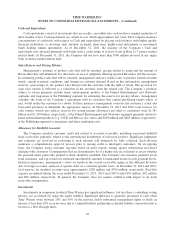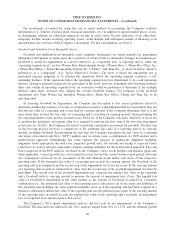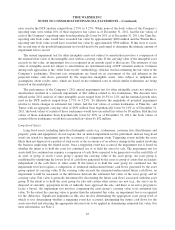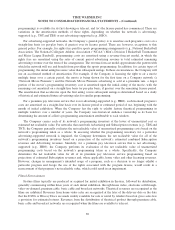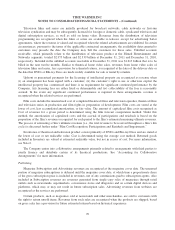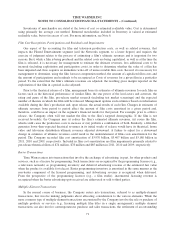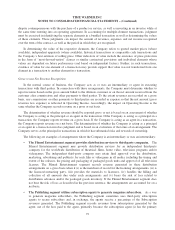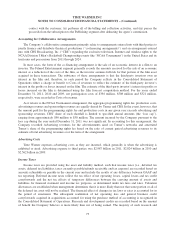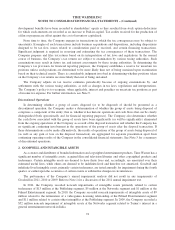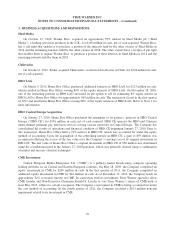Time Magazine 2011 Annual Report Download - page 80
Download and view the complete annual report
Please find page 80 of the 2011 Time Magazine annual report below. You can navigate through the pages in the report by either clicking on the pages listed below, or by using the keyword search tool below to find specific information within the annual report.TIME WARNER INC.
NOTES TO CONSOLIDATED FINANCIAL STATEMENTS – (Continued)
For investments accounted for using the cost or equity method of accounting, the Company evaluates
information (e.g., budgets, business plans, financial statements, etc.) in addition to quoted market prices, if any,
in determining whether an other-than-temporary decline in value exists. Factors indicative of an other-than-
temporary decline include recurring operating losses, credit defaults and subsequent rounds of financing at an
amount below the cost basis of the Company’s investment. For more information, see Note 4.
Goodwill and Indefinite-Lived Intangible Assets
Goodwill and indefinite-lived intangible assets, primarily tradenames, are tested annually for impairment
during the fourth quarter or earlier upon the occurrence of certain events or substantive changes in circumstances.
Goodwill is tested for impairment at a level referred to as a reporting unit. A reporting unit is either the
“operating segment level,” such as Warner Bros. Entertainment Group (“Warner Bros.”), Home Box Office, Inc.
(“Home Box Office”), Turner Broadcasting System, Inc. (“Turner”) and Time Inc., or one level below, which is
referred to as a “component” (e.g., Sports Illustrated,People). The level at which the impairment test is
performed requires judgment as to whether the operations below the operating segment constitute a self-
sustaining business. If the operations below the operating segment level are determined to be a self-sustaining
business, testing is generally required to be performed at this level; however, if multiple self-sustaining business
units exist within an operating segment level, an evaluation would be performed to determine if the multiple
business units share resources that support the overall Goodwill balance. For purposes of the goodwill
impairment test, Time Warner has identified Warner Bros., Home Box Office, Turner and Time Inc. as its
reporting units.
In assessing Goodwill for impairment, the Company has the option to first assess qualitative factors to
determine whether the existence of events or circumstances leads to a determination that it is more likely than not
that the fair value of a reporting unit is less than its carrying amount. If the Company determines that it is not
more likely than not that the fair value of a reporting unit is less than its carrying amount, then performing the
two-step impairment review process is unnecessary. However, if the Company concludes otherwise or elects not
to perform the qualitative assessment, then it is required to perform the first step of the two-step impairment
review process. In 2011, the Company elected not to perform a qualitative assessment for goodwill. The first step
of the two-step process involves a comparison of the estimated fair value of a reporting unit to its carrying
amount, including Goodwill. In performing the first step, the Company determines the fair value of a reporting
unit using a discounted cash flow (“DCF”) analysis and, in certain cases, a combination of a DCF analysis and a
market-based approach. Determining fair value requires the exercise of significant judgment, including
judgments about appropriate discount rates, perpetual growth rates, the amount and timing of expected future
cash flows, as well as relevant comparable company earnings multiples for the market-based approach. The cash
flows employed in the DCF analyses are based on the Company’s most recent budgets and business plans and,
when applicable, various growth rates are assumed for years beyond the current business plan period. Discount
rate assumptions are based on an assessment of the risk inherent in the future cash flows of the respective
reporting units. If the estimated fair value of a reporting unit exceeds its carrying amount, the Goodwill of the
reporting unit is not impaired and the second step of the impairment test is not necessary. If the carrying amount
of a reporting unit exceeds its estimated fair value, then the second step of the goodwill impairment test must be
performed. The second step of the goodwill impairment test compares the implied fair value of the reporting
unit’s Goodwill with its carrying amount to measure the amount of impairment loss, if any. The implied fair
value of Goodwill is determined in the same manner as the amount of Goodwill recognized in a business
combination (i.e., the estimated fair value of the reporting unit is allocated to all of the assets and liabilities of
that reporting unit including any unrecognized intangible assets as if the reporting unit had been acquired in a
business combination and the fair value of the reporting unit was the purchase price paid). If the carrying amount
of the reporting unit’s goodwill exceeds the implied fair value of the reporting unit’s goodwill, an impairment
loss is recognized in an amount equal to that excess.
The Company’s 2011 annual impairment analyses did not result in any impairments of the Company’s
Goodwill. The discount rates utilized in the 2011 analysis ranged from 10% to 11.5% and the terminal growth
66


